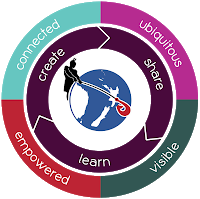Kia ora koutou,
Today DFI session was focused on Devices. We were looking at the background of how Manaiakalani have come to use 1:1 devices, and more importantly how to use shared devices. We were reminded that as teachers it's so important to be able to put yourself in a learners shoes and practice using the same tools that they do (as normally teachers are equipped with macbooks or hp laptops, rather than chromebooks). We need to know what functionality their devices have (AND don't have!) in order to set up new learning activities for tamariki.
The other key component of today was looking at the Manaiakalani Cybersmart curriculum.
This needs to be an integral part of our teaching programme. If we're going to be giving learners access to the world with a device, it's crucial that they're given the tools through an intentional cybersmart curriculum to become smart learners, building smart relationships and creating a smart digital footprint. This links with not only Te Whariki NZ ECE Curriculum vision, but also Manaiakalani pedagogy of Learn Create Share being connected confident and empowered lifelong learners.

Three key areas:
- Cybersmart is about creating positive language. SMART - rather than SAFE (which implies danger and has negative connotations)
- Learners need opportunities to develop Cybersmart relationships. This is where blogging and commenting on blogs is useful.
- Explicit teaching of the Cybersmart curriculum (within contexts) is necessary, and the smart learners, smart footprints, and smart relationships components should be addressed at the beginning of every year.
Today were asked to create a screencastify of one of the cybersmart areas, I chose smart values. Before yesterday I had never heard of Screencastify, therefore I was totally lost! However, through rewindable learning, once again saved the DAY. So I gave it a go...
Noho ora mai,
Tracy





